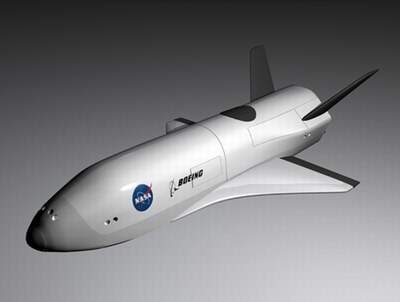Tue, Apr 22, 2003
 Boeing engineers are designing the Orbital Space
Plane (OSP) for NASA utilizing nearly 50 years of expertise in
producing spacecraft. Boeing is one of three contractor teams
developing proposals for the program which includes the spacecraft,
ground operations and all supporting technologies needed to conduct
missions to and from the International Space Station.
Boeing engineers are designing the Orbital Space
Plane (OSP) for NASA utilizing nearly 50 years of expertise in
producing spacecraft. Boeing is one of three contractor teams
developing proposals for the program which includes the spacecraft,
ground operations and all supporting technologies needed to conduct
missions to and from the International Space Station.
 Boeing was awarded a $45 million contract
modification on the NASA Space Launch Initiative program for work
on the space plane. The modification extends the current contract
through July 2004.
Boeing was awarded a $45 million contract
modification on the NASA Space Launch Initiative program for work
on the space plane. The modification extends the current contract
through July 2004.
The Orbital Space Plane will be a multipurpose spacecraft that
can perform crew rescue vehicle and crew transfer vehicle missions
for the space station. It will be compatible with current
expendable rockets and future reusable launch vehicles and will
seat four to six people. “Our experience from Mercury to
Gemini, from Apollo to the space shuttle, gives us significant
knowledge base and proficiency to build upon, “ said Volker
Roth, program manager for Boeing on this program in Huntsville,
Ala. “We are drawing on the best of industry for this
team.”

OSP also draws upon research conducted with the X-37 built by
Phantom Works, the research and development unit of Boeing. The
X-37 (seen below) serves as a test bed for 40 airframe, propulsion
and operational technologies designed to make space transportation
more affordable. Under the Space Launch Initiative, Boeing will
determine a technical and program approach for a future Orbital
Space Plane. The concept definition phase is scheduled to last 16
months and includes a series of systems engineering trade
studies.
 The
results will be more specific definitions and solutions based on
requirements set by NASA. This includes program elements, estimated
life cycle cost for various alternatives and vehicle design
recommendations.
The
results will be more specific definitions and solutions based on
requirements set by NASA. This includes program elements, estimated
life cycle cost for various alternatives and vehicle design
recommendations.
“Space is a challenging environment,” added Roth.
“The Orbital Space Plane will be designed to provide safe,
reliable and affordable access to space for humans.” NASA is
expected to proceed with full-scale development of the OSP before
the end of 2004. In addition to this contract effort, Boeing is
preparing to compete for the next phase of the OSP in 2004. Boeing
Phantom Works will manage the Orbital Space Plane Phase A Program
from facilities in Huntsville, Ala., and will employ about 120
persons in Houston, Huntington Beach, Calif., and the Kennedy Space
Center, Fla.
More News
Also: B-29 Superfortress Reunion, FAA Wants Controllers, Spirit Airlines Pulls Back, Gogo Galileo Van's Aircraft posted a short video recapping the goings-on around their reorganiz>[...]
Light Gun A handheld directional light signaling device which emits a brilliant narrow beam of white, green, or red light as selected by the tower controller. The color and type of>[...]
"The journey to this achievement started nearly a decade ago when a freshly commissioned Gentry, driven by a fascination with new technologies and a desire to contribute significan>[...]
"Our driven and innovative team of military and civilian Airmen delivers combat power daily, ensuring our nation is ready today and tomorrow." Source: General Duke Richardson, AFMC>[...]
Aircraft Conflict Predicted conflict, within EDST of two aircraft, or between aircraft and airspace. A Red alert is used for conflicts when the predicted minimum separation is 5 na>[...]
 Airborne 04.16.24: RV Update, Affordable Flying Expo, Diamond Lil
Airborne 04.16.24: RV Update, Affordable Flying Expo, Diamond Lil ANN's Daily Aero-Term (04.20.24): Light Gun
ANN's Daily Aero-Term (04.20.24): Light Gun Aero-News: Quote of the Day (04.20.24)
Aero-News: Quote of the Day (04.20.24) Aero-News: Quote of the Day (04.21.24)
Aero-News: Quote of the Day (04.21.24) ANN's Daily Aero-Term (04.21.24): Aircraft Conflict
ANN's Daily Aero-Term (04.21.24): Aircraft Conflict






